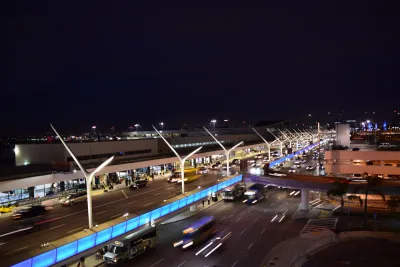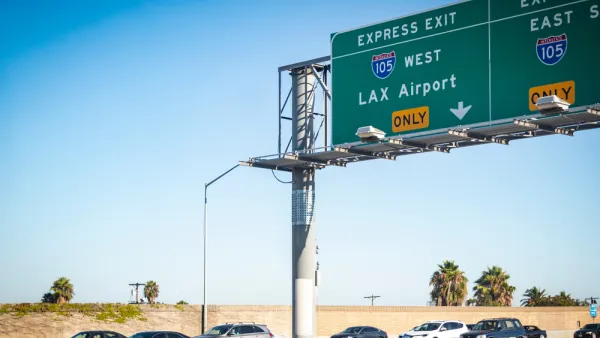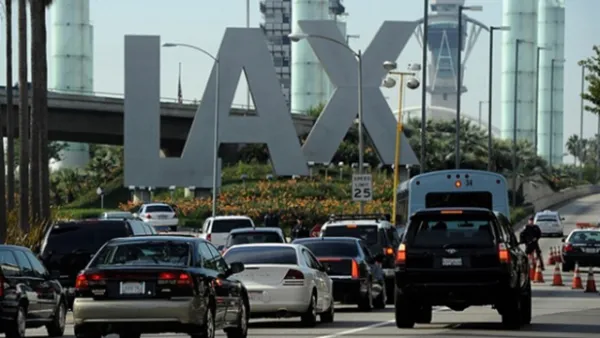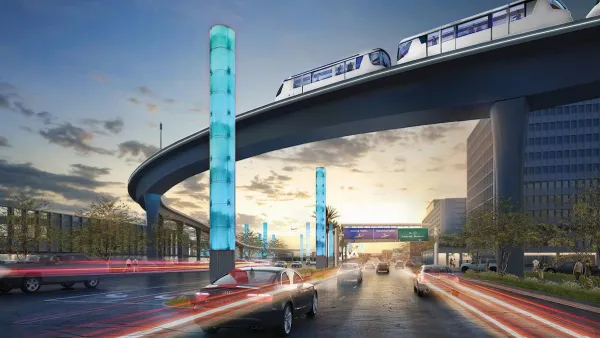Automobile traffic to LAX has increased by half in the last decade, and congestion has passed a tipping point.

Anyone who has ever dropped off a friend at the Los Angeles International Airport or stepped onto the curb at the arrivals level to wait for a Flyaway (ok, I am talking about myself here) knows the airport's capacity for surpassing the worst nightmares of congestion. A plan to ban ride-hailing companies like Lyft and Uber from making curbside pickups is intended to lesson congestion and free-up road space for more efficient modes of transportation.
Laura J. Nelson and Alex Wigglesworth report on the big changes coming to LAX, as announced by Los Angeles World Airports (the airport authority for the city of Los Angeles) officials on Friday last week.
Starting at the end of October, travelers leaving LAX will be required to board a shuttle or walk to a waiting area east of Terminal 1 to hail an Uber, Lyft or taxi. Drop-off policies, and pickups for family and friends, will not change.
The plan will remain in place until the completion of an elevated airport train, scheduled for 2023. The people-mover will arrive every two minutes and will whisk passengers between the terminals, a car rental facility, a ground transportation hub and a Metro station.
According to the article, Uber and Lyft account for about 27 percent of the 100,000 car trips at LAX in an average day. Blocking the ride-hailing companies from picking up passengers curbside is expected to benefit every other kind of transportation coming in and out of the airport, which have been struggling as car trips to the airport have exploded.
"Meanwhile, ridership plummeted on high-occupancy buses and shuttles, data show. Trips on LAX’s FlyAway buses fell by two-thirds, as did rides on shared vans such as SuperShuttle and Prime Time. Courtesy shuttles to car rental facilities, parking lots and hotels saw a 20% decline," according to the article.
The airport won't just ban ride-hailing pickups and hope for the best: the plan also includes changes to the street design at the arrivals level, where curbside lanes will be converted to bus-only lanes.
FULL STORY: Will ending curbside pickups for Uber, Lyft and taxis help LAX’s traffic?

Analysis: Cybertruck Fatality Rate Far Exceeds That of Ford Pinto
The Tesla Cybertruck was recalled seven times last year.

National Parks Layoffs Will Cause Communities to Lose Billions
Thousands of essential park workers were laid off this week, just before the busy spring break season.

Retro-silient?: America’s First “Eco-burb,” The Woodlands Turns 50
A master-planned community north of Houston offers lessons on green infrastructure and resilient design, but falls short of its founder’s lofty affordability and walkability goals.

Test News Post 1
This is a summary

Analysis: Cybertruck Fatality Rate Far Exceeds That of Ford Pinto
The Tesla Cybertruck was recalled seven times last year.

Test News Headline 46
Test for the image on the front page.
Urban Design for Planners 1: Software Tools
This six-course series explores essential urban design concepts using open source software and equips planners with the tools they need to participate fully in the urban design process.
Planning for Universal Design
Learn the tools for implementing Universal Design in planning regulations.
EMC Planning Group, Inc.
Planetizen
Planetizen
Mpact (formerly Rail~Volution)
Great Falls Development Authority, Inc.
HUDs Office of Policy Development and Research
NYU Wagner Graduate School of Public Service




























